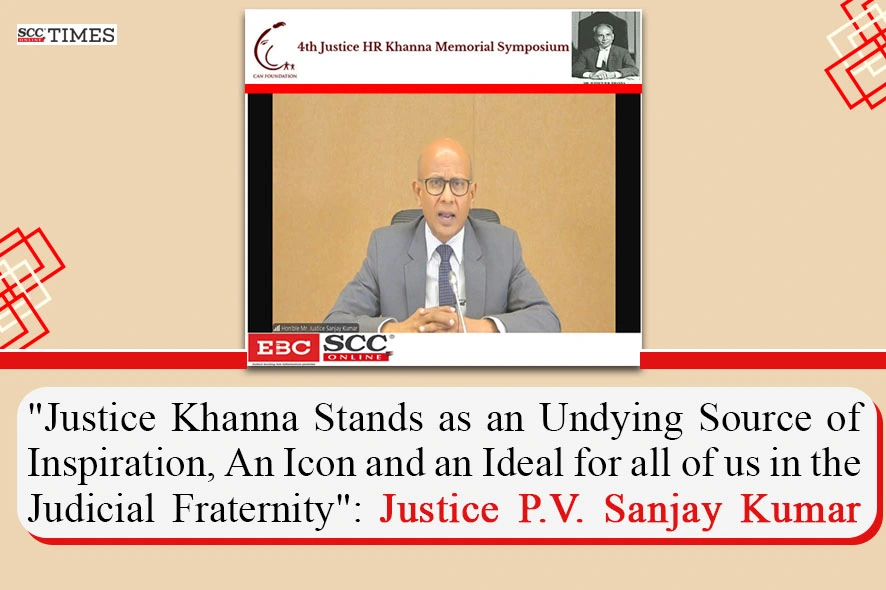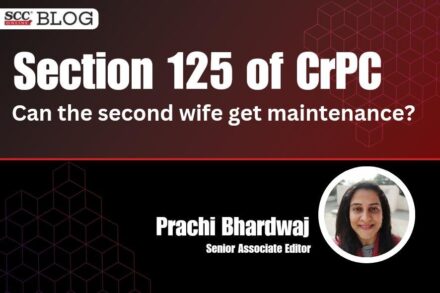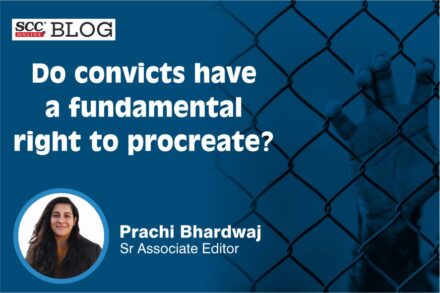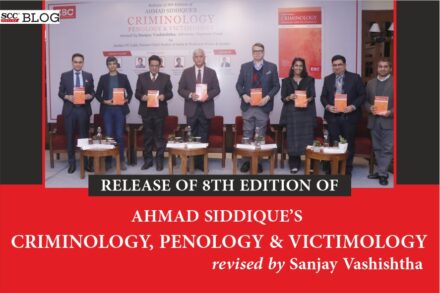“Justice Khanna Stands as an Undying Source of Inspiration, An Icon and an Ideal for All of us in the Judicial Fraternity”: Justice P.V. Sanjay Kumar at 4th Justice HR Khanna Memorial Symposium | Can Foundation
He [Justice H.R. Khanna] attained such heights that he will forever remain a shining beacon to those whose quest is to uphold constitutional values & liberties.
~ Justice P.V. Sanjay Kumar at ‘4th Justice HR Khanna
Memorial National Symposium’
National Academy of Legal Studies & Research (NALSAR) University, Hyderabad & Dharmashastra National Law University, Jabalpur (DNLU) in collaboration with CAN Foundation hosted the 4th Justice H. R. Khanna Memorial National Symposium in remembrance of the illustrious persona of Late Justice H.R. Khanna, on 6th July 2024 (Saturday). There were two themes of the symposium with each theme being taken up in different sessions. The 1st session was on “Contours Of The Basic Structure Of Our Constitution”.
This Session of the Symposium was graced by Justice P.V. Sanjay Kumar, (Judge, Supreme Court of India), who was the Chief Guest at the Symposium & Justice Sunita Agarwal, Chief Justice, High Court of Gujarat as the Special Guest.
The session was moderated by a panel of young and upcoming lawyers of the nation, which comprised of Mrs. Bhavana C. Dhoundiyal (Associate, Kachwaha & Partners, New Delhi), Mr. Abhikalp Pratap Singh (AOR, Supreme Court of India), Mr. Sriram Parakkat (AOR, Supreme Court of India) & Mr. Siddharth Sharma (Advocate, High Court of Madhya Pradesh).
Justice Kumar, in their scintillating address demonstrated deep respect and admiration for the esteemed figures who have greatly influenced the basic structure of the Constitution. Justice Kumar compared the Constitutions of Germany, Bosnia & Herzegovina, Afghanistan, Turkey and Brazil, discussing ‘eternity’ clauses, contrasting them with India’s Constitution. Justice Kumar agreed with Justice Khanna’s argument that the amending power under Article 368 could not touch the foundation or alter the basic institutional pattern of the Constitution.
While speaking on the Kesavananda Bharati case, Justice Kumar paid homage to Late Justice H.R. Khanna, who has left their mark on the Indian judiciary. Highlighting the contributions in the jurisprudence of amendments to the Indian Constitutional Law, he said:
“The very use of the word ‘amendment’ was taken to be of guidance by the Supreme Court in Kesavananda Bharati and the phrase ‘amendment of the Constitution’ was interpreted to mean that the amended original Constitution would still remain standing and the power of amendment would not be a source to bring about a new Constitution.”
After expressing their reverence for Justice Khanna, Justice Kumar then proceeded to discuss the changes in the Constitution. Justice Kumar began with noting the concepts given by various academicians, such as Professor Gary Jeffrey Jacobsohn’s ideals of constitutional identity & Professor Vicki Jackson’s notion of transnational constitutional norms and how each affects the basic structure. Justice Kumar opined:
“Amendment would alter the provisions within certain existing parameters while dismemberment would be a total and foundational alteration, departing from the existing framework.”
Justice Kumar then went on to discuss the amendments made in the Indian Constitution, tracing the history from Sankari Prasad Singh Deo v. Union of India, which challenged the first constitutional amendment of 1951, to Sajjan Singh v. State of Rajasthan, which challenged the 17th Amendment of the Constitution of 1964, Golak Nath, and earlier case of Re. Berubari Union, and concluded with the Kesavananda Bharati case, which challenged the amendments. He whilst commending the remarkable judgments delivered by Justice Khanna, noted that:
“Justice Khanna’s opinion, amongst the majority, is one of the leading opinions on the issue of basic structure.”
Justice Kumar further elaborated on the other major opinions which suggested that democracy, secularism, rule of law, federalism, judicial review, and separation of powers should constitute the basic features of the Constitution. However, as Mr. P.B. Mehta noted in ‘The Inner Conflict of Constitutionalism,’ the Apex Court had not fully thought through the principle, often picking out items from the Constitution without specifying why.
“It was only in Kesavananda Bharati that the Court developed the basic structure doctrine extensively but the test in that regard was not laid down in clear and concise terms.”
Justice Kumar also addressed the issue of whether exercise of the power of amending the Constitution would entitle abridgment or taking away of fundamental rights, with reference to the usage of words ‘the Constitution shall stand amended’ in Article 368. Justice Kumar noted that Justice Khanna recognized the necessity and purpose behind providing for amendment of the Constitution, stressing that the framers of the Constitution sought to balance the need for continuity with the urge for change. Further, whilst referring to the Constituent Assembly Debates, Justice Kumar opined:
“A conscious decision was taken not to include the proposed amendment of the Draft Constitution moved by Dr. P.S. Deshmukh to the effect that no amendment which is calculated to infringe or restrict or diminish the scope of any individual rights, any rights of a person or persons, with respect to property or otherwise, shall be permissible under the Constitution and any amendment which has or is likely to have such an effect shall be void and ultra vires.”
Justice Kumar concluded their address by underscoring the dynamic nature of constitutional law, noting that both the Constitution and the principles of constitutional law must evolve to remain relevant. Justice Kumar echoed the sentiment of Justice Khanna, who believed that liberty lies in the hearts of men and women and that no Constitution, law, or court can preserve it if it dies in the hearts of the people, further emphasising the responsibility of every citizen to respect and uphold the Constitution, while fulfilling their duties and obligations in following words :
“I would conclude that just as our Constitution cannot be rigid and static the principles of constitutional law. Both must grow and evolve as per the need of the hour to be contemporaneously relevant in society and to serve their purpose within the boundaries of the basic structure of our Constitution.”
Address by Justice Sunita Agarwal, (Chief Justice, High Court of Gujarat)
Justice Sunita Agarwal delivered a thought-provoking address, invoking the words of Justice K.K. Mathew from the landmark Kesavananda Bharati v. State of Kerala judgement:
“The Preamble serves as a guiding light, a beacon, leading us towards a society based on Justice, Liberty, Equality, and Fraternity.”
Justice Agarwal emphasised that the Constitution of India was crafted in light of the Objectives Resolution adopted by the Constituent Assembly. The drafters aimed to create a document that eradicates exploitation, provides equal growth opportunities, and empowers citizens to actively pursue these goals.
Justice Agarwal elaborated that the Preamble’s significance transcends its symbolic value; it acts as a touchstone for constitutional interpretation. This was notably evident in the Kesavananda Bharati case, where the Supreme Court examined the scope of the amending power under Article 368. Justice Agarwal said that
“Our Constitution is not merely a political document; it is essentially a social document based on social philosophy. Apart from setting up the machinery of government, it has a noble and grand vision in the Preamble.”
Justice Agarwal further explained that the Preamble was crafted by individuals who had endured exploitation and injustice under foreign rule for centuries. These individuals, who sacrificed so much, aspired for a nation rooted in equality and justice, as articulated in the Objectives Resolution.
Justice Agarwal also emphasised that all organisations and bodies should strive to realise this vision, adhering to the principles enshrined in the Constitution and avoiding exploitation. Justice Agarwal stated,
“The Constitution is supreme over all organisations and bodies. All owe their existence to it, and none can claim superiority over the others. Each must function within the four corners of the Constitution.”
Justice Agarwal also highlighted how the Preamble seeks to form an integrated community, preserving and protecting differences while upholding the supreme law of the Constitution. The Preamble’s first four objectives—justice, equality, liberty, and fraternity—embody the aspirations of the Indian people.
Justice Agarwal underscored that by declaring India as sovereign, the Preamble signifies that citizens are the masters of the nation, advocating for a democratic setup. Commitment to secularism calls for an equitable distribution of resources and opportunities, ensuring development benefits reach the last person in society, a concept of distributive justice. Justice Agarwal emphasised that secularism and democracy ensure the inclusion of all races, castes, creeds, religions, and sexes in public policy and state welfare schemes, thereby demonstrating principles of inclusive justice.
Justice Agarwal further referenced Indira Gandhi v. Raj Narain case, where the Supreme Court held that the principle of free and fair elections is an essential postulate of democracy, which in turn is a basic structure of the Constitution. Justice Agarwal noted that the Preamble represents the nation’s aspirations and ideals, guiding it towards these goals.
Justice Agarwal then discussed S.R. Bommai v. Union of India, highlighting the bench’s emphasis on the Preamble’s promise of liberty of thought, expression, belief, faith, and worship, alongside equal status and opportunity. This protects individual dignity and prevents discrimination based on religion, race, caste, and creed.
Justice Agarwal whilst emphasising on Janhit Abhiyan v. Union of India, discussing the economic status as a basis for reservation, underscored :
“Economic disparity acts as a criterion for reservation and compensatory discrimination, the Hon’ble Supreme Court found that economic criterion is intrinsically linked with distributive justice envisaged under the Preamble, along with Article 38 and 46 of the Constitution.”
Justice Agarwal then observed on the judgement of Justice Subba Rao in State of Kerala v. NM Thomas which transformed the equality jurisprudence in India from that of formal equality to substantial equality, thus also changing the understanding of the concept of reservation. Justice Agarwal noted:
“The meaning and extent of Basic Structure needs to be construed in view of the principles laid down in the Preamble of the Constitution. The specific provisions of the Preamble forms the yarn from which the Basic Structure has to be woven.”
Justice Agarwal concluded the first session of the Symposium by noting that the Preamble acts as the guiding light for the legal and societal framework, as the nation continues to navigate the complexities of governance and societal challenges, and encouraged citizens to remain steadfast and stay committed to the principles of the Preamble, thereby staying true to the values of the Constitution.
“These specific provisions enacted in the Preamble alone can determine the basic structure of the Constitution. These specific provisions, either separately or in combination determine the content of the great concepts set out in the Preamble.”
The Entire Session can be viewed at: https://www.youtube.com/watch?v=I2sWBUyr7kE
SCC-EBC group were the Knowledge Partners of the event with Bar and Bench as the Media Partner.







